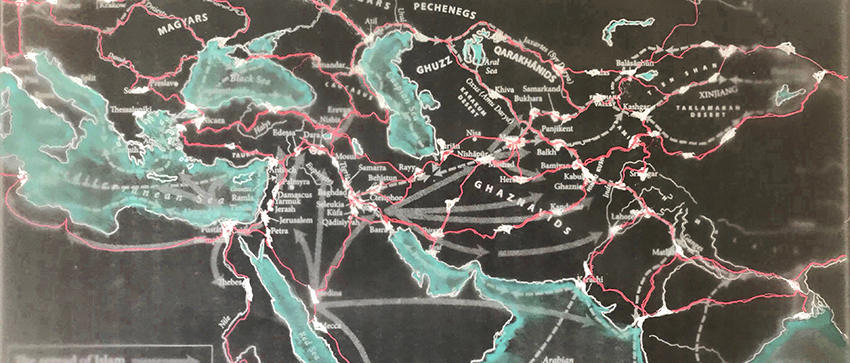Kaart 9. – netwerk for english see below
Dit gebied was het epicentrum van de wereld; in het midden van de zijderoute, sterk verbonden met verre uithoeken via een netwerk van wegen dat zich uitstrekte in alle richtingen. De steden Damascus, Samarkand, Bagdad en Balasagun (dichtbij de huidige hoofdstad Bishkek), lagen als aaneengeregen parels langs de wervelkolom van Azië en verbonden zo de Stille Oceaan met de Middellandse Zee, aldus Peter Frankopan in The Silkroads.
Deze kaart uit ongeveer 1030 n.C. laat Balashagun (9. bij de huidige hoofdstad Bishkek) zien als centrum van de wereld. De maker was Oeigoerse wetenschapper Mahmud al- Kashghari. 1. Bulgarije 2. Kaspische zee 4. Alexandrië 5. Egypte 7. Japan 11. Samarkant. De gele stippen zijn steden.
Om dit gebied als centrum van de wereld te laten zien heb ik ook mijn eigen wereldkaart omgekeerd door Amerika naar de rechterkant te plaatsen:
Individuele contacten gingen slechts over korte afstanden, maar het gehele web van lokale gemeenschappen leidde tot een complexe wereld, waar ideeën verhalen en kennis over en weer gingen. Zijde was het symbool van macht en kon gebruikt worden als betaalmiddel. Daarnaast werd er ook gehandeld in slaven, zilver, goud, papier, wijn, zadels, pijlen, porselein, keramiek, pigment, was, honing, gedroogd fruit, peper, kruidnagels, kaneel, topaas, barnsteen, tin, koper, lood, parelmoer, lichtgevende stenen, glas, wierook, ebbenhout, turkoois, lapis lazuli, cederhout, vachten. De oevers van rivieren als de Wolga en de Neva waren bezaaid met graven waarin goud lag dat geslagen was in Samarkand. Goud en zijde uit dit gebied werd gevonden tot in graven langs de kusten van Denemarken en Noorwegen, aldus Peter Frankopan.
De nieuwe wegen in Kirgistan worden door de Chinezen gebouwd als onderdeel van hun strategie om een goede infrastructuur aan te leggen en daarmee optimale verbindingen voor handel te verkrijgen. En invloed.
zie ook: 1 grond/ground 2 nomadisch bestaan/nomad life 3 vilt/felt 4 mest/manure 5 wit/white 6 verhalen/stories 7 biodiversiteit/biodiversity 8 gevaar/danger onderzoek/research art meets science
Map 9. – Network
This region was the epicentre of the world; with strong connections to the distant corners via a network of roads that extended in all directions. The cities of Damascus, Samarkand, Bagdad and Balasagun (near the current capital city of Bishkek) lay like pearls threaded on a chain along the spinal column of Asia, thus connecting the Pacific Ocean with the Mediterranean Sea, according to Peter Frankopan in The Silk Roads.
The map dates from approx. 1030 A.D. shows Balasagun (9. Near the current capital city of Bishkek) as the centre of the world. The cartographer was the Uyghur scientist Mahmud al- Kashghari. 1. Bulgaria 2. Caspian Sea zee 4. Alexandria 5. Egypt 7. Japan 11. Samarkand. The yellow dots are cities.
In order to show this region as the centre of the world, I have reversed my own map, by positioning America on the right-hand side.
Individual contacts were only made across short distances, but the whole web of local communities resulted in a complex world, where ideas, stories and knowledge were passed back and forth. Silk was the symbol of power and could be used as a means of payment. Trade could also take place in slaves, silver, gold, paper, wine, saddles, arrows, porcelain, ceramics, pigment, wax, honey, dried fruit, pepper, cloves, cinnamon, topaz, amber, tin, copper, lead, mother-of-pearl, fluorescent stones, glass, incense, ebony, turquoise, lapis lazuli, cedarwood, skins. The banks of rivers such as the Volga and the Neva were littered with graves containing gold that had been beaten in Samarkand. Gold and silk originating from this region was found as far in graves as far as the coasts of Denmark and Norway, according to Peter Frankopan.
The new roads in Kyrgyzstan are being built by the Chinese as part of their strategy to develop a good infrastructure and thus ensure optimal trade connections. And influence.
